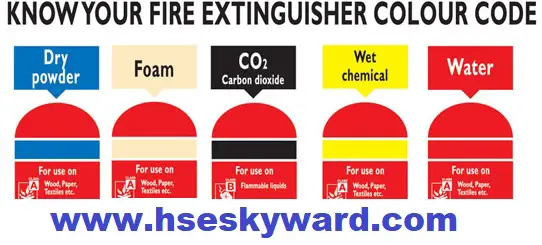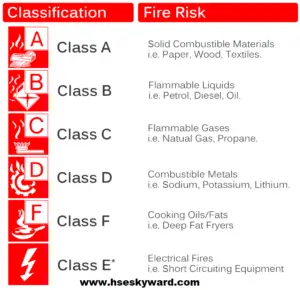Types of fire extinguishers and their suitability

Types of fire extinguishers and their suitability
Types of fire extinguishers and their suitability. Whether a fire extinguisher must be present in your company is determined in the Risk Inventory & Evaluation. In addition, it may be that the presence of a fire extinguisher is made compulsory by the insurance company or any national compliance authority or body. There are different types of fire extinguishers, but not all fire extinguishers are suitable for every situation. what are classes of fire
Below is an overview of the advantages and disadvantages of fire extinguishers. Types of fire extinguishers? There are different types of fire extinguishers. Fire extinguishers come in all shapes and sizes. The fire extinguishers used for the workers with training are very necessary especially in the case of hot work activity and job watcher or whole watcher is appointed who extinguishes the fire in a fire even.

Following are the approved types of the fire extinguishers
Powder fire extinguishers
Foam fire extinguishers
Carbon dioxide snow extinguishers (CO2 extinguishers)
Special fire extinguishers such as metal fire extinguishers and fat fire extinguishers
Water-Fire extinguishers
Powder fire extinguishers are fire extinguishers that contain a special extinguishing fine power of sodium bicarbonate, potassium bicarbonate or monoammonium phosphate the powder coats the fuel & smother the fire. Powder fire extinguisher available in 1, 2, 6, 9 and 12 kg even 25 and 50 kg and are denoted by blue color. Difference between a powder extinguisher and a foam extinguisher
Operation: The extinguishing action of powder is a complicated chemical story. Simply explained, extinguishing powder breaks into the “combustion” chemical process and interrupts this process.
Suitable for? The following fire classes can be combated with a powder extinguisher:
1. class A: solids (e.g. wood)
2. class B: liquids (e.g. gasoline)
3. class C: gases (e.g. natural gas)
| Advantages | Disadvantages |
| Frost resistant good extinguishing effect live equipment can be extinguished Fast effect Almost universally applicable | Extinguishing powder causes a lot of collateral damage Hardly any cooling effect Risk of re-ignition of the fire Short extinguishing time •Affects electrical equipment Attacks electrical equipment |
Foam extinguishers contain a mixture of water and the foaming agent called Aff.
Operation: The effect of extinguishing foam is mainly based on covering the fire. This means that oxygen can no longer reach the fire, which means that it is extinguished. In addition, extinguishing foam has a cooling effect. A foam fire extinguisher is available in 2, 6 and 9 litters and is denoted by cream color. Classes of fire according to international standards
Suitable for: The following fire classes can be combated with a foam extinguisher:
1. class A: solids (e.g. wood)
2. class B: liquids (e.g. gasoline)
| Advantages | Disadvantages |
| • extinguishes without collateral damage • long spray duration • easy operation Equipment under voltage can be extinguished thanks to the cooling effect, less chance of re-ignition | a foam extinguisher is more expensive than a powder extinguisher |
Carbon dioxide extinguishers: You can recognize carbon dioxide extinguishers by the large black tube from which the extinguishing substance comes out. This extinguisher is less suitable for home, garden and kitchen use because you must be able to handle it well. The end of the tube becomes very cold (-80 ° C), so that you can sustain third-degree burns. Therefore, always hold the extinguisher by the handle this is denoted by black color.
Operation: The operation of a carbon dioxide extinguisher is based on expelling the oxygen in a fire. The carbon dioxide provides this.
Suitable for: The following fire classes can be combated with a carbon dioxide extinguisher:
Class A: solids (e.g. wood)
Class B: liquids (e.g. gasoline)
Class C: gases (e.g. natural gas)
| Advantages | Disadvantages |
| No collateral damages Live equipment can be extinguished Frost resistant No aggressive substances Smothered the fire | Unsuitable for home (user must be trained) Suffocating for humans and animals cannot be used in confined space Can cause cold burns (frost wounds) Blows quickly Relatively expensive Professional use required Can suffocate by removing oxygen if used inside closed space e.g. confined space. Types of fire extinguishers and their suitability |
Fat fire extinguisher
Is also called wet chemical and is denoted by yellow color
Suitable for Class F (burning of fats) & also applicable to class A fires
| Advantages | Disadvantages |
| Can be used directly on a burning frying pan | Not suitable for gas fires Not frost resistant Expensive to purchase |
Water extinguisher
A water extinguisher usually contains more than just water. An additive is then added to the water. This ensures that the water droplets can spread better and more effectively over the fire it is denoted by red color. Types of fire extinguishers and their suitability.
Suitable for?
Water extinguishers are suitable for class A fires.
| Advantages | Disadvantages |
| Excellent surface penetration and cooling properties, which helps to rapidly reduce the flames. | Only can be used on Class A fires. If used on oils will aggravate the fire. Electrocution hazard if used on electrical fires |






